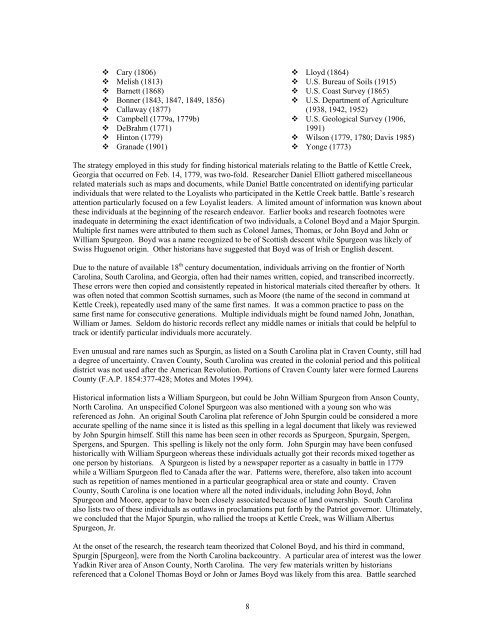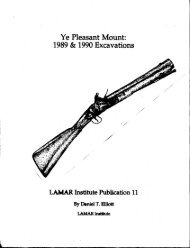Stirring Up a Hornet's Nest: - UGA Laboratory of Archaeology ...
Stirring Up a Hornet's Nest: - UGA Laboratory of Archaeology ...
Stirring Up a Hornet's Nest: - UGA Laboratory of Archaeology ...
You also want an ePaper? Increase the reach of your titles
YUMPU automatically turns print PDFs into web optimized ePapers that Google loves.
� Cary (1806)<br />
� Melish (1813)<br />
� Barnett (1868)<br />
� Bonner (1843, 1847, 1849, 1856)<br />
� Callaway (1877)<br />
� Campbell (1779a, 1779b)<br />
� DeBrahm (1771)<br />
� Hinton (1779)<br />
� Granade (1901)<br />
8<br />
� Lloyd (1864)<br />
� U.S. Bureau <strong>of</strong> Soils (1915)<br />
� U.S. Coast Survey (1865)<br />
� U.S. Department <strong>of</strong> Agriculture<br />
(1938, 1942, 1952)<br />
� U.S. Geological Survey (1906,<br />
1991)<br />
� Wilson (1779, 1780; Davis 1985)<br />
� Yonge (1773)<br />
The strategy employed in this study for finding historical materials relating to the Battle <strong>of</strong> Kettle Creek,<br />
Georgia that occurred on Feb. 14, 1779, was two-fold. Researcher Daniel Elliott gathered miscellaneous<br />
related materials such as maps and documents, while Daniel Battle concentrated on identifying particular<br />
individuals that were related to the Loyalists who participated in the Kettle Creek battle. Battle’s research<br />
attention particularly focused on a few Loyalist leaders. A limited amount <strong>of</strong> information was known about<br />
these individuals at the beginning <strong>of</strong> the research endeavor. Earlier books and research footnotes were<br />
inadequate in determining the exact identification <strong>of</strong> two individuals, a Colonel Boyd and a Major Spurgin.<br />
Multiple first names were attributed to them such as Colonel James, Thomas, or John Boyd and John or<br />
William Spurgeon. Boyd was a name recognized to be <strong>of</strong> Scottish descent while Spurgeon was likely <strong>of</strong><br />
Swiss Huguenot origin. Other historians have suggested that Boyd was <strong>of</strong> Irish or English descent.<br />
Due to the nature <strong>of</strong> available 18 th century documentation, individuals arriving on the frontier <strong>of</strong> North<br />
Carolina, South Carolina, and Georgia, <strong>of</strong>ten had their names written, copied, and transcribed incorrectly.<br />
These errors were then copied and consistently repeated in historical materials cited thereafter by others. It<br />
was <strong>of</strong>ten noted that common Scottish surnames, such as Moore (the name <strong>of</strong> the second in command at<br />
Kettle Creek), repeatedly used many <strong>of</strong> the same first names. It was a common practice to pass on the<br />
same first name for consecutive generations. Multiple individuals might be found named John, Jonathan,<br />
William or James. Seldom do historic records reflect any middle names or initials that could be helpful to<br />
track or identify particular individuals more accurately.<br />
Even unusual and rare names such as Spurgin, as listed on a South Carolina plat in Craven County, still had<br />
a degree <strong>of</strong> uncertainty. Craven County, South Carolina was created in the colonial period and this political<br />
district was not used after the American Revolution. Portions <strong>of</strong> Craven County later were formed Laurens<br />
County (F.A.P. 1854:377-428; Motes and Motes 1994).<br />
Historical information lists a William Spurgeon, but could be John William Spurgeon from Anson County,<br />
North Carolina. An unspecified Colonel Spurgeon was also mentioned with a young son who was<br />
referenced as John. An original South Carolina plat reference <strong>of</strong> John Spurgin could be considered a more<br />
accurate spelling <strong>of</strong> the name since it is listed as this spelling in a legal document that likely was reviewed<br />
by John Spurgin himself. Still this name has been seen in other records as Spurgeon, Spurgain, Spergen,<br />
Spergens, and Spurgen. This spelling is likely not the only form. John Spurgin may have been confused<br />
historically with William Spurgeon whereas these individuals actually got their records mixed together as<br />
one person by historians. A Spurgeon is listed by a newspaper reporter as a casualty in battle in 1779<br />
while a William Spurgeon fled to Canada after the war. Patterns were, therefore, also taken into account<br />
such as repetition <strong>of</strong> names mentioned in a particular geographical area or state and county. Craven<br />
County, South Carolina is one location where all the noted individuals, including John Boyd, John<br />
Spurgeon and Moore, appear to have been closely associated because <strong>of</strong> land ownership. South Carolina<br />
also lists two <strong>of</strong> these individuals as outlaws in proclamations put forth by the Patriot governor. Ultimately,<br />
we concluded that the Major Spurgin, who rallied the troops at Kettle Creek, was William Albertus<br />
Spurgeon, Jr.<br />
At the onset <strong>of</strong> the research, the research team theorized that Colonel Boyd, and his third in command,<br />
Spurgin [Spurgeon], were from the North Carolina backcountry. A particular area <strong>of</strong> interest was the lower<br />
Yadkin River area <strong>of</strong> Anson County, North Carolina. The very few materials written by historians<br />
referenced that a Colonel Thomas Boyd or John or James Boyd was likely from this area. Battle searched










